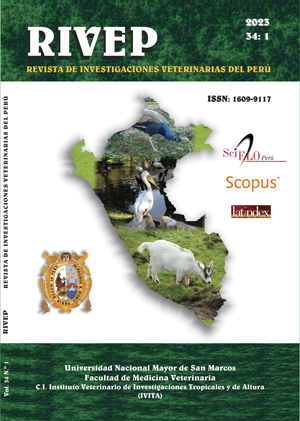Perceptions of producers on the welfare of double purpose cattle in the Eastern plains of Colombia
DOI:
https://doi.org/10.15381/rivep.v34i1.23129Keywords:
welfare, consensus, cattle, indicators, opinionAbstract
The aim of this observational-cross-sectional study was to determine the attitudes of producers regarding the welfare (CW) of double-purpose (DP) cattle. A face-to-face survey was carried out with 20 DP producers from Meta, Colombia to quantify their perceptions (using 5-point Likert scales) on the level of impact that environmental, health and management aspects have on CW and on the level of importance of indicators (environmental, management, health and affective states) of CW evaluation. The average scores awarded to each aspect and indicator were calculated. The Kruskal-Wallis test was used to assess differences between categories of impact aspects and between categories of indicators. The health aspects were considered the ones with had the greatest impact (4.07/5), while the indicators of affective states were considered the least important (3.82). The key aspects categorized as 'Extreme Impact' factors were external parasite load (4.65), not checking colostrum intake (4.65), heat stress (4.55), myiasis (4.25) and disbudding/dehorning without anesthesia (4.25). Key indicators recognized as 'Essential' were access to shade (4.65), colostrum intake (4.55), staff skills (4.5), pup mortality (4.45) and drinking water (4.45). The results highlight the existing consensus between the impact of heat stress and the importance of the presence of shade as an indicator of CW, as well as between colostrum consumption and calf mortality. Likewise, there is evidence of a disagreement between the high impact of disbudding /dehorning without anesthesia and the low level of importance perceived as an essential indicator of CW.
Downloads
Downloads
Published
Issue
Section
License
Copyright (c) 2023 Catalina Medrano-Galarza, Aldemar Zúñiga López, Diego G. Ahumada Beltrán, Diana M.K. Rojas-Morales, Jaime A. Cubides-Cárdenas, Fredy E. García Castro

This work is licensed under a Creative Commons Attribution 4.0 International License.
AUTHORS RETAIN THEIR RIGHTS:
a. Authors retain their trade mark rights and patent, and also on any process or procedure described in the article.
b. Authors retain their right to share, copy, distribute, perform and publicly communicate their article (eg, to place their article in an institutional repository or publish it in a book), with an acknowledgment of its initial publication in the Revista de Investigaciones Veterinarias del Perú (RIVEP).
c. Authors retain theirs right to make a subsequent publication of their work, to use the article or any part thereof (eg a compilation of his papers, lecture notes, thesis, or a book), always indicating the source of publication (the originator of the work, journal, volume, number and date).



